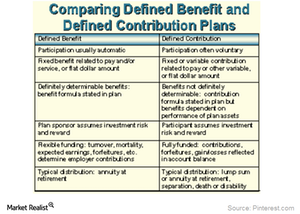What Does General Electric’s Pension Plan Entail?
Under a defined contribution plan, the employer contributes a fixed amount to the fund on behalf of the employee.
March 13 2017, Updated 5:05 p.m. ET

Defined contribution plan
Under a defined contribution plan, the employer contributes a fixed amount to the fund on behalf of the employee. Employees can also make their own contributions to the retirement fund.
The 401(k) is a common defined contribution plan. This plan structure ensures the employer’s autonomy in selecting the financial asset class: stocks, ETFs, or money market instruments. Under this plan, the risk to an employer is minimal. Upon an employee’s retirement, the total available funds depend on the employer’s contributions, the employee’s savings, along with the performance of financial assets in which the money was invested.
Defined benefit plan
The defined benefit plan guarantees a predetermined sum for an employee’s retirement by the employer. In order to fulfill this promise, the employer must make some specific assumptions such as the expected return on pension plan assets, compensation growth, tenure, and the discount rate for pension and other post-retirement obligations. The employer must watch the progress of the pension fund to monitor whether the plan succeeds based on these assumptions.
General Electric’s pension plan
General Electric (GE) invests the funds collected in the defined benefit pension plan in various financial asset types. The difference between the pension obligation and the fair value of the plan’s assets denotes the overfunded or underfunded status of the pension plans.
If the defined benefit plan fails to perform in line with its assumptions, it can backfire on the employer. Unlike the defined contribution plan, the investment risk is undertaken by the employer in a defined benefit plan. As a result, companies like GE, Boeing (BA), Honeywell International (HON), and Lockheed Martin (LMT) would need to close the gap between plan obligations and the fair value of the plan’s assets.
After the 2008 recession, many companies shifted toward defined contribution pension plans.
